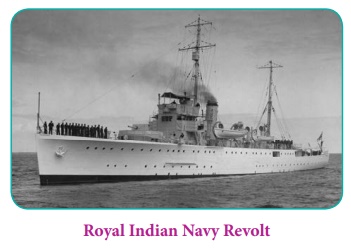Last Phase of Indian National Movement | History - The Royal Indian Navy Revolt | 12th History : Chapter 7 : Last Phase of Indian National Movement
Chapter: 12th History : Chapter 7 : Last Phase of Indian National Movement
The Royal Indian Navy Revolt
The Royal Indian Navy Revolt
The
economic impact of the war was manifest in rising prices, shortage of
food-grains and closure of war time industries causing retrenchment and
employment. This merged with the anti-British sentiments evident in the mass
scale of the protests revolving around the INA trials.
B.C.
Dutt, a rating (the designation for the Indians employed in the various
war-ships and elsewhere in the Royal Indian Navy) in the HMIS Talwar was arrested for scribbling ‘Quit
India’ on the panel of the ship. This provoked a strike by the 1,100 ratings on
the ship. The ratings resented the racist behaviour of the English commanders,
the poor quality of the food and abuses that were the norm. Dutt’s arrest
served as the trigger for the revolt on February 18, 1946. The day after, the
revolt was joined by the ratings in the Fort Barracks and the Castle and a
large number of them went into the Bombay cities in commandeered trucks waving
Congress flags and shouting anti-British slogans.

Soon, the
workers in the textile mills of Bombay joined the struggle. The trade unions in
Bombay and Calcutta called for a sympathy strike and the two cities turned into
war zones. Barricades were erected all over and pitched battles fought.
Shopkeepers downed shutters and hartals became the order of the day. Trains
were stopped in the two cities with people sitting on the tracks. On news of
the Bombay revolt reaching Karachi, ratings in the HMIS Hindustan and other naval establishments in Karachi went on a lightning strike on February 19. The strike wave
spread to almost all the naval establishments across India and at least 20,000
ratings from 78 ships and 20 shore establishments ended up revolting in the
days after February 18, 1946. There were strikes, expressing support to the
ratings in the Royal Indian Air Force stationed in Bombay, Poona, Calcutta,
Jessore and Ambala units. The Sepoys in the army cantonment station at Jabalpur
too went on strike.
The
ratings, in many places, hoisted the Congress, the Communist, and the Muslim
League flags together on the ship masts during the revolt.
The
colonial government’s response was brutal repression. It was, indeed, a revolt
without a leadership; nor did the ratings move in an organised direction. While
the trade unions came out in solidarity with the ratings in no time and the
strikes in Bombay and Calcutta and Madras were strong expressions against
British rule in India, these did not last for long and the ratings were forced
to surrender soon.
Sardar
Vallabhai Patel, then in Bombay, took the initiative to bring the revolt to an
end. The RIN mutiny, however, was indeed a glorious chapter in the Indian
National Movement and perhaps the last act of rebellion in the long story of
such acts of valour in the cause of independence.
The March 23, 1940 resolution read as follows: ‘That
geographically contiguous units are demarcated into regions which should be so
constituted, with such territorial readjustments as may be necessary, that the
areas in which the Muslims are numerically in a majority as in the north-western
and eastern zones of India should be grouped to constitute “Independent
States”, in which the constituent units shall be autonomous and sovereign.’
(Source: Sumit Sarkar Modern India 1885-1947, Pearson, 2018,)
Related Topics